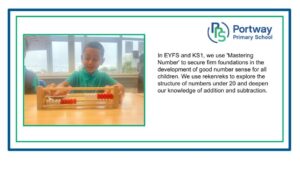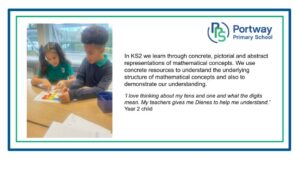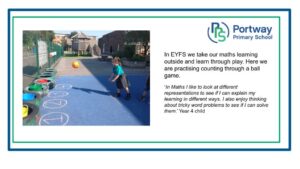Mathematics
Mathematics is an inter-connected and highly creative subject that has been developed over centuries, providing solutions to some of the world’s most interesting problems. It is essential to everyday life, academic discipline and employment, with the power to change lives. Our Maths curriculum has been designed so that pupils are taught to think mathematically so that they can understand numbers, geometry and measures.
At Portway, we are passionate about our pupils leaving primary school with a sound foundation in the fundamentals of mathematics and the ability to reason, problem solve and follow lines of inquiry. Central to this lays a sense of pleasure and curiosity about the subject we hope to foster throughout our whole school community.
Our maths unit coverage provides detailed information as to how we teach all elements of the curriculum.



How is mathematics taught at Portway?
At Portway Primary, we use a ‘Teaching for Mastery’ approach to Mathematics. We also supplement our curriculum in Years 1-6 with a programme called Power Maths. These are high quality textbooks and practice workbooks that support our teachers to plan and deliver mathematically rich and supportive lessons. Each lesson provides opportunities for our pupils to intelligently practise, retrieve, refine and apply their mathematical knowledge.
Our Maths curriculum is designed to help pupils form a Maths mental model within their long term memories mental model theory states that all knowledge is organised into units. A mental model is, therefore, a conceptual system for understanding knowledge. Our Maths mental model is a way of organising mathematical semantic and procedural knowledge in a meaningful way; it is an appreciation of how knowledge is connected and the ways in which it is connected.
Big Ideas help form the basis of our Maths mental model. Big Ideas are concepts that underpin the subject. In Maths, these are:
- Understanding Numbers
- Understanding and using Measure
- Understanding Geometry
Each Big Idea has knowledge strands which help to strengthen the mental model. Learning knowledge in each of the strands allows pupils to express and demonstrate their understanding of the Big Idea, which gradually develops as pupils return to them over and over again.

What is ‘Teaching for Mastery’?
When taught to master Maths, children develop their conceptual and procedural fluency without having to resort to rote learning. As a result, they are able to solve non-routine problems in unfamiliar contexts without relying on memorised procedures. Not only do they understand how to solve problems, but can use their conceptual understanding to explain why their solution works.
We all learn together…
In Maths lessons at Portway, where possible, the whole class moves through topics and concepts at broadly the same pace. We spend longer time on key mathematical topics and concepts in order to give all learners both the practice and depth of understanding they need. We believe that all pupils can achieve success in Maths. There is nobody who ‘can’t do Maths’.
We challenge pupils by asking them to explore mathematical concepts in more depth rather than accelerate them onto new content. This has been found to have real benefits to children’s ability to access more complex mathematical ideas as they get older.
We learn deeply…
We give our pupils enough time to explore core concepts and ideas in mathematics at a deep level in order to foster their relational and conceptual understanding. This slower pace and focus on depth eventually leads to greater progress because it gives all learners the chance to become secure. As a result, each year we are able to build new learning onto children’s existing knowledge.
We use representations…
At Portway we use concrete apparatus (things pupils can touch, hold and manipulative) and visual representations (things they can see) to help children to visualise and internalise mathematical concepts. This allows them to access and understand the mathematical structure of the concepts they are learning about. Through the consistent use of these apparatus and representation, our pupils gain confidence as independent learners to use resources and solve problems.
Why do we use this approach?
Our approach is developed from mastery teaching approaches and pedagogy used by Singapore and other high performing territories. This has produced a high level of achievement for these areas. Singapore ranks first globally for achievement in Mathematics and has been within the top 5 nations since 1995. This is true for learners of all abilities, as the graph below demonstrates.
Our approach is also based on empirical research and sound educational theory. We have followed advice from theorists who are widely considered experts in maths education such as Jerome Bruner, Richard Skemp, Lev Vygotsky and Zoltan Dienes.
The Department for Education, the National Centre for Excellence in the Teaching of Mathematics (NCETM), the National Curriculum Review Committee and OFSTED have all emphasised the pedagogy of Mathematics teaching developed in Singapore and the teaching for mastery approach.
Power Maths is also one of the few resources currently on the Department for Education’s recommended textbook list. In order to achieve this, the programme was required to participate in a 3-step independent evaluation process.
Mathematics across the curriculum
Pupils get to rehearse, apply and consolidate their Maths learning in other areas of the curriculum. Careful planning ensures pupils continue developing all areas of Maths in other subjects.
